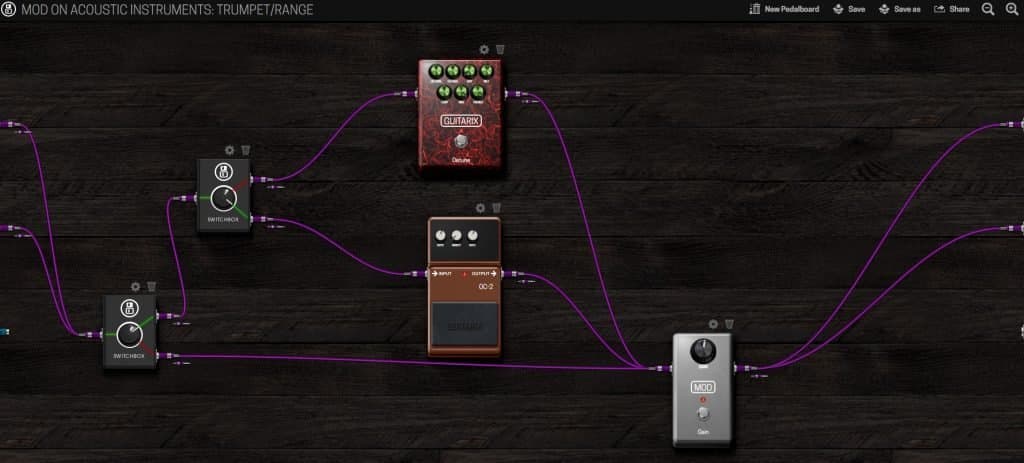Most musicians know from the gear history that pedals and stompboxes are usually meant for guitar players, however with MOD Duo you can connect any instrument, even the acoustic ones. All you need is a pick up or a microphone with a jack connection.
In this series of blog posts we’ll show how you can use various acoustic instruments together with the MOD Duo. We will be talking in detail about how to add, enhance or weaken different aspects of the sound coming from an acoustic instrument. For the first entry we chose the trumpet.
Let’s see what are the core aspects of the sound from a trumpet:
- The frequency range is in the mid-high: E3 (165 Hz) to B5 (988 Hz)
- It has a potential and rich harmonic structure
- The formants are:
- 800 Hz
- 1750 Hz
- 2800 Hz
- 55 – 95 dB(SPL) of dynamic range
- There is a windy noise
Frequency range
Frequency range is the difference between the lowest and highest perceived tone (pitch). The best way to increase this is by using pitch shifters. The Duo has two pitch shifters, the “OC-2” and the “GX detune”. The “OC-2” is used if you want to sound an octave lower and the detuner is good for going an octave up.
Pedalboard:
Let me explain it a little bit the pedalboard above. The trumpet sound goes into a switch, it decides if you want dry sound of the input, without the effect or wet sound with the effect. The other switch decides whether you want to go an octave up, using the detuner “GX detune”. Or an octave down, using the “OC-2”. This is all connected to a master volume gain and that’s basically it.
Harmonic structure
The harmonic structure tells something about the spectral structure of the sound. This might be a little hard to understand but basically it is all the aspects of the sound that change together with the pitch. If we talk about a rich harmonic structure it means that it has a lot of aspects that change together with the pitch. A poor harmonic structure means that it doesn’t have that much of other aspects that change together with the pitch. One way to increase the harmonic structure is to use distortion. A way to decrease the harmonic structure is to use filters.
Pedalboard:
Once again we have the system with two footswitches here. One is for dry, input sound without effect, or wet, input sound with effect, and the other footswitch is to increase or decrease harmonic structure. Please note the extra volume gains I put after the filter and distortion. This is because you’re also increasing or decreasing volume when you change the harmonic structure. The filter values are based on the minimum and maximum frequency of the trumpet.
Formants
The formants on an instruments are the tones (frequencies) that are always in the sound. They come independently from the perceived pitch. Although you don’t notice them very well, as soon as you change them the sounds changes a lot. One way to increase formants is with a ring modulator. A way to decrease them is with an equalizer.
Pedalboard:
We use the two footswitches here again and also the master volume gain stays the same. The ring modulator adds an extra sinewave and multiplies the sound of the trumpet by the same wave, creating some other formants. The equalizer is set in a way that the natural formants of the trumpet (see the beginning of this post) are completely silent but the rest of the sound stays the same. Please also note the levels of the volume gains after the ring modulator and the equalizer same as in the pedalboard before.
Dynamic Range
The trumpet has quite a broad dynamic range. This means that the difference between the loudest and the softest a trumpet player can play is quite big. To increase this range we can use an expander, to decrease we use a compressor. These are the basic ways to do this but not the most compelling ones, this should be the job of the mixing guy on a stage and not yours. What’s more interesting is that there is a number of plugins that use the input volume to change the sound. For example, the “Autowah”. This plugin controls a filter by using the input volume of the trumpet. It’s used quite a lot by trumpet players.
Pedalboard:
So here I put the compressor to actually decrease the volume range of the trumpet. This is to make the “Autowah” more controllable. Play with the volume gain on the end of the setup and change level of the compressor to see what fits best.
Windy noise
The noise we are talking about is the one that made Chet Baker famous. A classical trumpet player will try to have as little of it as possible while some of the jazz players will try to have as much as they can. So how to increase or decrease this sound? For decreasing we will use some filter and gate plugins. For increasing we will use a noise generator and the envelope filter.
Pedalboard:
Let’s start by decreasing it. At first we take a gate, this mutes the sound if it’s below a certain volume. Then we add a filter that will kill all the noise below the first frequency of the trumpet. And another filter is to kill high clicks. Sound increasing is done by a “pink noise generator”, which mixes the trumpet with noise. To get this mix right we also use the envelope filter again. This time we use the sidechain option from the envelope filter. With this you allow a second signal to control the filter (see previous part in the blog). Which in this case is the compressed trumpet.
I hope you’ve enjoyed this post.
Pjotr Lasschuit
